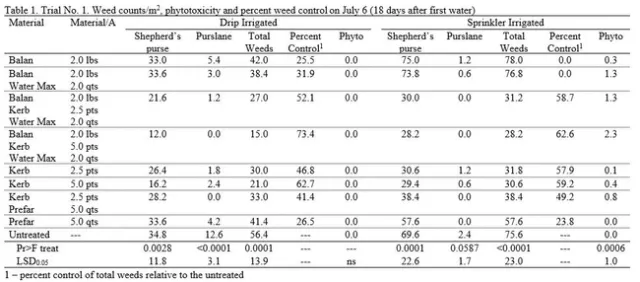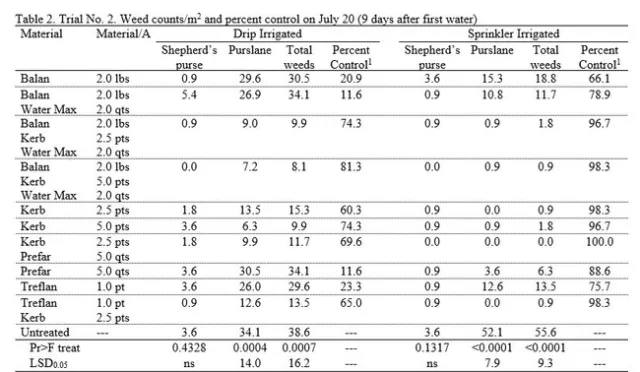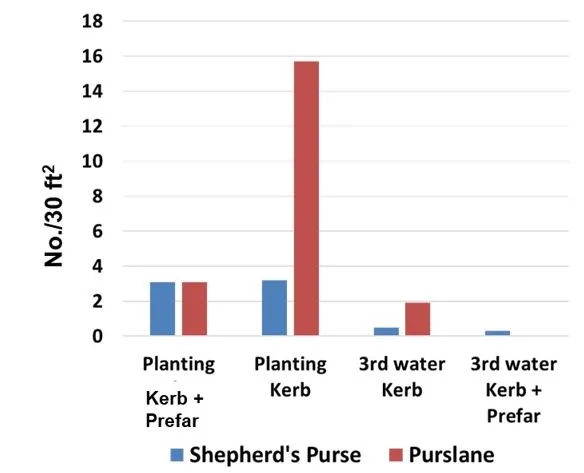Effect of Irrigation Method on Herbicide Efficacy in Lettuce Production
University of California Cooperative Extension, Monterey County
Author: Richard Smith, Farm Advisor
In 2020 we compared the efficacy of lettuce preemergent herbicides in trials with fields split between season-long drip vs sprinkler irrigation. The trials were conducted on sites with sandy soils along the Salinas River. In the first trials shepherd's purse was the dominant weed and in the second trial purslane was dominant. In both trials there were fewer weeds in the drip irrigated side of the field (Tables 1&2). This observation is consistent with a prior evaluation at the Spence Research Station in which we observed 85% fewer weeds in drip irrigated plots than in sprinkler irrigated. It is not entirely clear why there tends to be fewer weeds in fields that are germinated with drip irrigation, but it may be because the soil surface may be drier in drip irrigated than in sprinkler irrigated fields.
The use of drip irrigation also affects the activation of the preemergent herbicides used in lettuce production. Prefar provides excellent control of purslane, however, in Trial No. 2 it only controlled 12% of the purslane in the drip irrigated plots compared to 89% in the sprinkler irrigated plots. The mobility of both Balan (Koc 10,000 mL/g) and Prefar (Koc 1433-4326 mL/g) are quite low in soil and once wetted by the upward moving drip water they quickly adhere to organic matter or clay and before moving far enough downward to get to the zone where weed seeds are germinating. Kerb on the other hand is more mobile in soil (Koc 548-1340 mL/g) than Balan or Prefar and controlled 60-74% of purslane in the drip irrigated plots and 97-98% in the sprinkler irrigated plots. Interestingly, in these trials Kerb provided greater control of purslane than Prefar in the sprinkler irrigated trials. This result is surprising given that on sandy soils during the summer, Kerb is easily leached deep enough with the first sprinkler germination irrigation, making it less effective in controlling small seeded weeds such as purslane and shepherd's purse (Figure 1). The reason for this is, if enough water is applied in the first germination water, Kerb is mobile enough to move below the top 0.5 inch of soil which is where most small-seeded weeds germinate. As a result, Kerb applied in the 2nd or 3rd germination water, which is typically a smaller quantity of water, keeps the Kerb in the zone of germinating weed seeds. But in these trials, Kerb worked better in the sprinkler irrigated evaluations which indicates that the ranch manager was extremely careful with his germination water applications and kept the Kerb in the area where it could provide good control of purslane.
The results in these trials give some insight into the activation of the lettuce preemergent herbicides with drip and sprinkler irrigation. These trials are specific to the soil type, condition and management at this site and may vary at other sites with different soil types and management. It is all about placement of the herbicides and it is important to understand the capacity of the irrigation system to activate and move the herbicide where it is needed. From these trials, materials such as Prefar and Balan were not as effectively moved into the soil and activated with drip irrigation. Kerb was effectively activated with drip, and unexpectedly, very well with sprinkler irrigation.

1 – percent control of total weeds relative to the untreated

1 – percent control of total weeds relative to the untreated
Figure 1. Number of weeds in Kerb and Prefar treatments irrigated with the first germination
Water (July 1) or on the third germination water (July 4, 2018)


